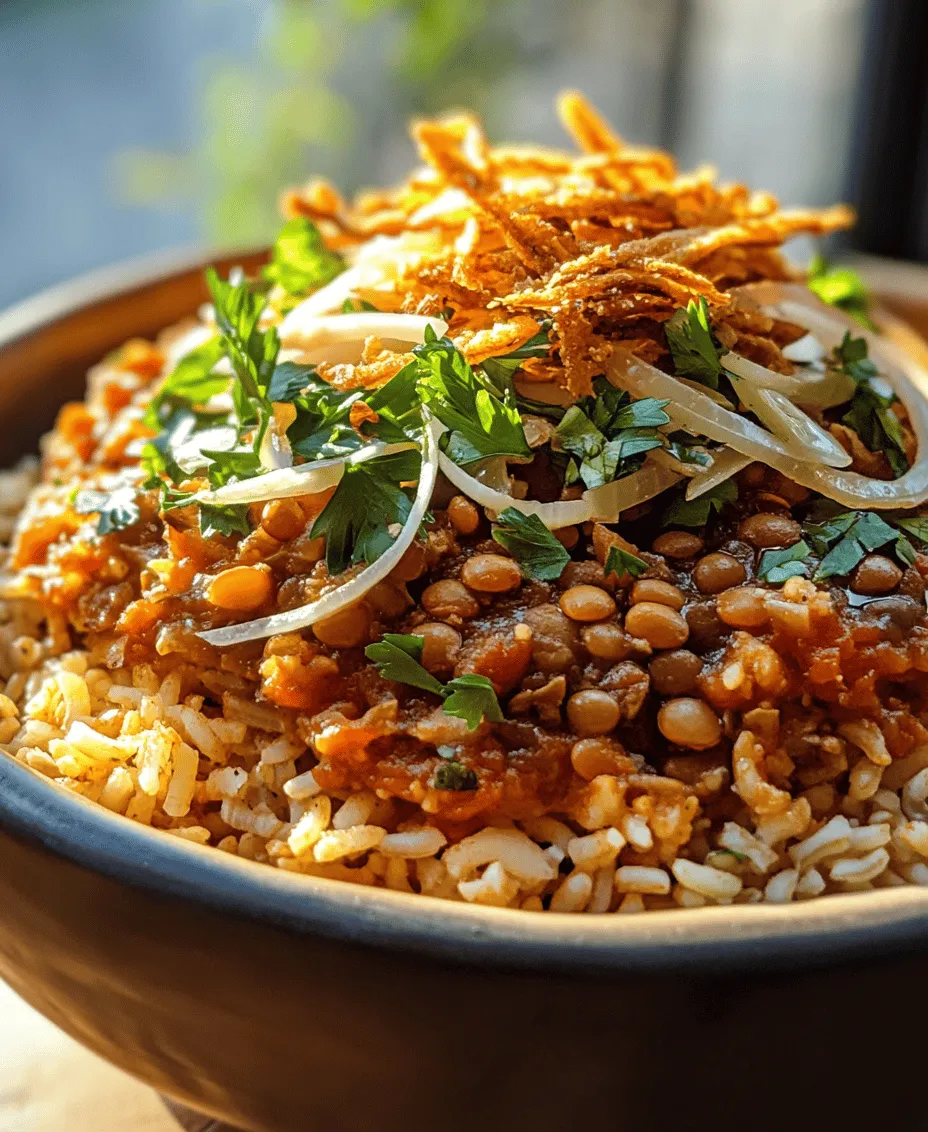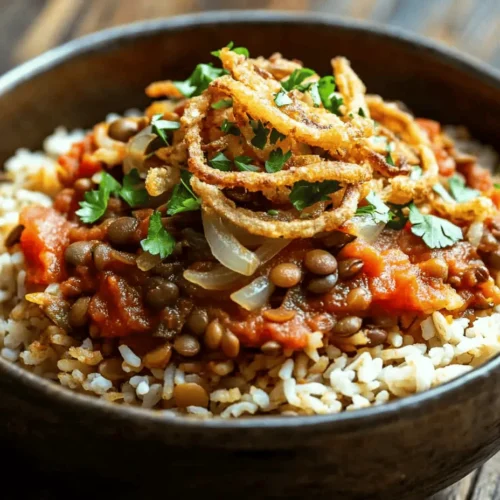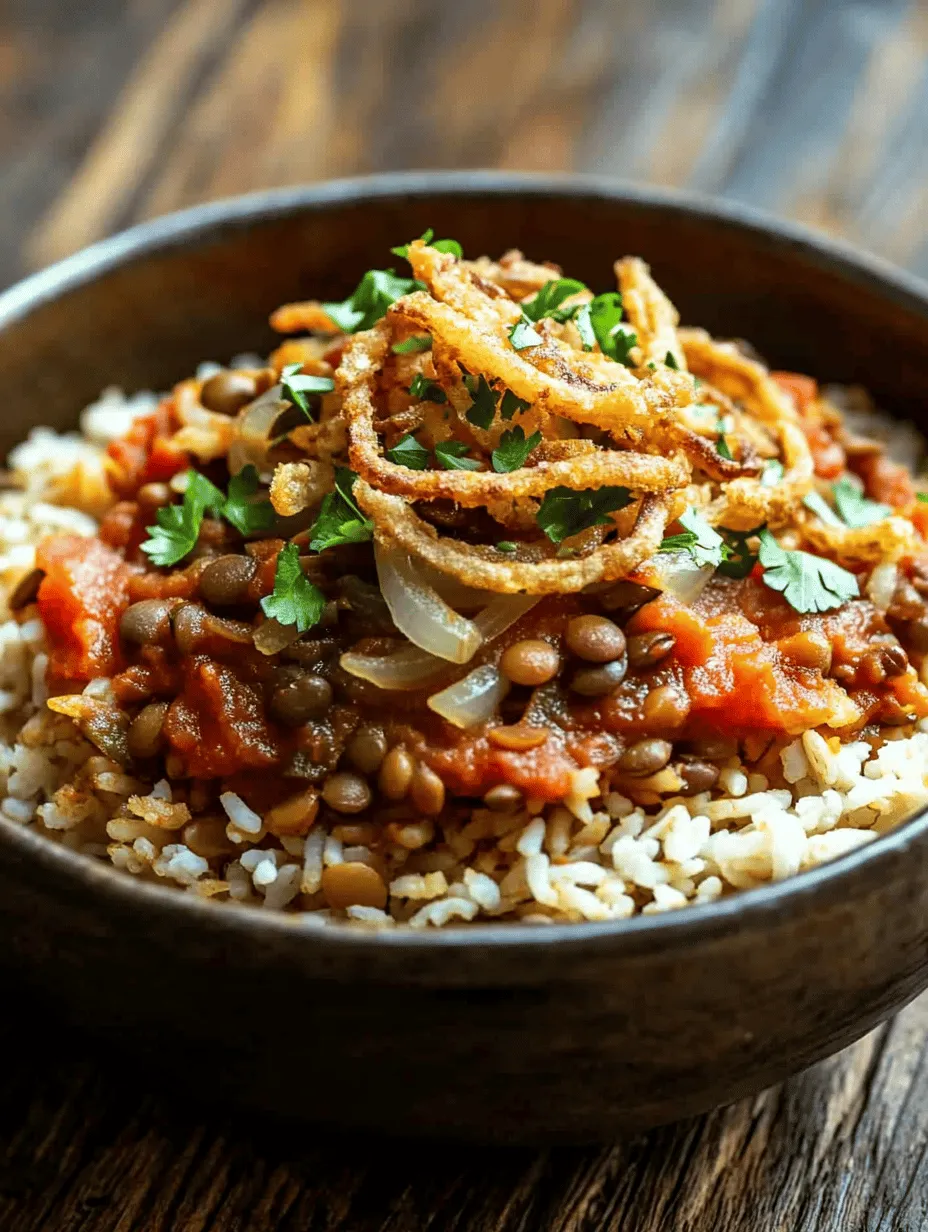Introduction
Koshari is not just a dish; it is a symbol of Egyptian culture. This hearty and vibrant meal, often referred to as Egypt’s national dish, is a delightful blend of flavors, textures, and history. Originating from the streets of Cairo, Koshari has captured the hearts and stomachs of both locals and tourists alike. As a staple of Egyptian cuisine, Koshari showcases the country’s ability to create comfort food that is both nutritious and satisfying.
In this article, we will delve into the rich history and cultural significance of Koshari, exploring how this dish has evolved over time. We will also take a closer look at the key ingredients that make Koshari not only delicious but also a powerhouse of nutrition. Finally, we will guide you through the step-by-step process of making this beloved dish in your own kitchen, ensuring you can enjoy a taste of Egypt no matter where you are in the world.
Understanding Koshari
Historical Background of Koshari and Its Origins in Egypt
The origins of Koshari are as complex as the dish itself. Traditionally, it is believed that Koshari emerged in Egypt during the 19th century, influenced by various culinary traditions brought by immigrants from different countries, including Italy and India. The dish’s initial foundation consisted of lentils and rice, gradually evolving to include pasta and chickpeas, reflecting the diverse influences that shape Egyptian cuisine.
Koshari was originally a meal for the working class, providing a filling and inexpensive option. Over the years, its popularity soared, transcending social classes and becoming a beloved dish in homes, restaurants, and street food stalls across Egypt. Today, Koshari is a unifying dish, often enjoyed during family gatherings and special occasions, embodying the spirit of communal dining.
The Evolution of the Dish and Its Place in Modern Egyptian Cuisine
As Egypt modernized, Koshari adapted to changing tastes and culinary practices. While traditional recipes remain, variations have emerged, incorporating local ingredients and innovative techniques. In contemporary cuisine, Koshari is not only enjoyed as a daily meal but also served at celebrations, making it a versatile dish that holds a cherished spot in the hearts of Egyptians.
Moreover, Koshari has gained international recognition, drawing attention from food enthusiasts around the globe. Culinary explorers seeking authenticity often find themselves indulging in Koshari when visiting Egypt, further solidifying its status as an icon of Egyptian gastronomy.
Cultural Significance and Occasions for Serving Koshari
Koshari is more than just food; it is a vessel for cultural expression. In Egypt, it is common to find Koshari served at weddings, religious festivities, and family gatherings. Its ability to bring people together around a shared table speaks to its role as a comfort food. Moreover, Koshari is often enjoyed during Ramadan, providing nourishment and sustenance after a day of fasting.
The dish’s significance extends beyond its taste; it represents the spirit of hospitality and generosity that is deeply rooted in Egyptian culture. When served to guests, Koshari is a testament to the host’s warmth and care, making it an essential part of social interactions.
Ingredients Breakdown
To create an authentic and delightful Koshari, understanding the ingredients is crucial. Each component plays a vital role in developing the dish’s flavor and nutritional profile. Here’s a breakdown of the key ingredients you’ll need:
Overview of the Key Ingredients in Koshari
Koshari typically consists of a combination of rice, lentils, macaroni, chickpeas, fried onions, and a rich tomato sauce, seasoned with a variety of spices. This medley of ingredients not only provides a satisfying meal but also offers a range of health benefits.
Nutritional Benefits of Each Ingredient
1. Brown Lentils: These legumes are a protein powerhouse, providing essential amino acids, fiber, and minerals like iron and magnesium. They are low in calories and high in nutrients, making them an excellent choice for those seeking a nutritious meal.
2. Rice: As a staple grain, rice serves as the energy backbone of Koshari. It complements the protein content of lentils and chickpeas, creating a balanced meal. Opting for whole grain rice can further enhance its nutritional value.
3. Elbow Macaroni: The addition of elbow macaroni brings a comforting texture to the dish. It provides carbohydrates that fuel the body while also adding variety to the overall mouthfeel of Koshari.
4. Onions and Garlic: These aromatic ingredients are essential for flavor enhancement. Onions are rich in antioxidants and have anti-inflammatory properties, while garlic is known for its immune-boosting benefits.
5. Spices: The combination of cumin, coriander, paprika, and cayenne pepper in Koshari is what elevates the dish’s flavor profile. Cumin aids digestion, coriander has anti-inflammatory properties, paprika adds color and sweetness, and cayenne provides a spicy kick.
6. Chickpeas: These legumes offer additional protein, fiber, and various vitamins and minerals. Their creamy texture complements the other ingredients, creating a delightful harmony of flavors.
7. Tomato Sauce: The heart of Koshari’s flavor, tomato sauce ties the dish together. Rich in lycopene, tomatoes have antioxidant properties that contribute to overall health.
8. Lemon Juice and Garnishes: A splash of lemon juice adds brightness and acidity, balancing the richness of the dish. Fresh herbs like parsley or cilantro can also be used as garnishes, enhancing the visual appeal and freshness of the meal.
Step-by-Step Instructions for Making Koshari
Now that you have a solid understanding of Koshari’s cultural significance and its key ingredients, it’s time to dive into the preparation. Below are the initial steps to guide you through creating this delightful dish in your own kitchen.
Step 1: Gather Your Ingredients
Before you start cooking, gather all your ingredients to ensure a smooth cooking process. Here’s what you’ll need:
– 1 cup brown lentils
– 1 cup rice (preferably basmati or long-grain)
– 1 cup elbow macaroni
– 1 can (15oz) chickpeas, drained and rinsed
– 2 large onions, thinly sliced
– 4 cloves of garlic, minced
– 1 can (15oz) tomato sauce
– 1 teaspoon ground cumin
– 1 teaspoon ground coriander
– 1 teaspoon paprika
– 1/2 teaspoon cayenne pepper (adjust to taste)
– Salt and pepper to taste
– Fresh lemon juice (to taste)
– Fresh parsley or cilantro for garnish
Step 2: Cook the Lentils and Rice
1. Prepare the Lentils: Rinse the brown lentils under cold water. In a pot, add the lentils and cover them with about 4 cups of water. Bring to a boil, then reduce the heat and let simmer for about 20-25 minutes or until tender. Be careful not to overcook them; they should hold their shape. Drain and set aside.
2. Cook the Rice: In a separate pot, rinse the rice until the water runs clear. Add the rice to a pot with 2 cups of water and a pinch of salt. Bring to a boil, then reduce the heat to low, cover, and let it simmer for 15-20 minutes or until the rice is fluffy and the water is absorbed. Fluff with a fork and set aside.
Step 3: Prepare the Macaroni
1. Cook the Macaroni: In a pot of salted boiling water, cook the elbow macaroni according to package instructions until al dente. Drain and set aside.
Step 4: Make the Tomato Sauce
1. Sauté Onions and Garlic: In a large skillet, heat some oil over medium heat. Add the sliced onions and sauté until they become golden brown and caramelized. This process adds depth and sweetness to the dish. Once browned, remove half of the onions and set them aside for garnish.
2. Add Garlic and Spices: To the remaining onions in the skillet, add the minced garlic and sauté for an additional minute until fragrant. Then, add the cumin, coriander, paprika, cayenne, salt, and pepper. Stir for a minute to toast the spices.
3. Add Tomato Sauce: Pour in the tomato sauce and bring it to a simmer. Let it cook for about 10 minutes, allowing the flavors to meld together. Adjust the seasoning as needed, and finish with a squeeze of fresh lemon juice for brightness.
Step 5: Assemble the Koshari
1. Layer the Ingredients: In a large serving dish, start layering the ingredients. Begin with a base of rice, followed by a layer of lentils, then the macaroni, and finally the chickpeas. Drizzle the tomato sauce over the top, ensuring an even distribution.
2. Garnish: Top with the reserved caramelized onions and any additional garnishes such as fresh parsley or cilantro. Serve with extra lemon wedges on the side for those who enjoy a zesty kick.
With these steps, you are well on your way to creating a delicious Koshari that embodies the heart of Egyptian cuisine. Stay tuned for the next part of this article, where we will delve deeper into serving suggestions, storage tips, and answers to common questions about Koshari.

Detailed Preparation of the Lentils
Lentils are a vital component of Koshari, contributing essential protein and texture to this beloved Egyptian dish. To prepare lentils for Koshari, it’s crucial to start with the right type. Brown or green lentils work best due to their firm texture that holds up well during cooking.
1. Rinse the Lentils: Begin by measuring out 1 cup of lentils. Rinse them under cold running water in a fine-mesh sieve to remove any debris or impurities. This step is essential for ensuring clean, properly cooked lentils.
2. Soaking (Optional): While most lentils do not require soaking, if you prefer a softer texture, you might soak them for 1-2 hours. This can help reduce cooking time and ensure even cooking.
3. Cooking the Lentils: In a medium-sized saucepan, combine the rinsed lentils with 3 cups of water or broth for added flavor. Bring the mixture to a boil over medium-high heat. Once boiling, reduce the heat to low, cover, and let them simmer for about 20-25 minutes. Check for doneness; the lentils should be tender but not mushy. If they need more time, continue simmering while checking every few minutes.
Cooking Techniques and Tips for Perfect Lentils
– Avoid Overcooking: It’s important not to overcook the lentils as they can become mushy. Check them frequently after the 20-minute mark.
– Salt at the Right Time: Add salt only after the lentils are cooked. Adding salt earlier can prevent them from softening properly.
– Flavor Boost: For additional flavor, consider adding bay leaves or garlic to the cooking water.
Preparing the Rice: Achieving the Right Texture
Rice is another staple in Koshari, providing a base for the rich flavors of the dish. To achieve the perfect fluffy rice:
1. Measure and Rinse: Use 1 cup of long-grain rice (preferably Egyptian rice). Rinse the rice under cold water until the water runs clear—this removes excess starch and prevents the rice from becoming sticky.
2. Cooking: In a medium saucepan, heat 2 cups of water and bring to a boil. Add a pinch of salt and the rinsed rice. Stir briefly, cover, and reduce the heat to low. Let the rice cook for about 15-20 minutes. Avoid lifting the lid during cooking to maintain steam.
3. Resting: Once cooked, remove the saucepan from the heat and let it sit, covered, for an additional 5-10 minutes. This resting period allows the rice to finish cooking and become fluffy.
Cooking the Elbow Macaroni: Timing and Texture Tips
The elbow macaroni adds a delightful layer to Koshari. For perfectly cooked macaroni:
1. Boiling Water: Bring a large pot of salted water to a rolling boil.
2. Cooking the Pasta: Add 1 cup of elbow macaroni and cook according to the package instructions, usually about 7-9 minutes. Stir occasionally to prevent sticking.
3. Al Dente: Aim for al dente, where the pasta is cooked but still has a slight bite. Drain the macaroni and rinse with cold water to stop the cooking process.
Creating the Tomato Sauce: Balancing Flavors
The tomato sauce is the heart of Koshari, providing acidity and flavor that ties the dish together.
1. Sautéing Onions: In a saucepan, heat 2 tablespoons of olive oil over medium heat. Add 1 finely chopped onion and sauté until translucent, about 3-4 minutes.
2. Adding Tomatoes: Stir in 1 can (14 oz) of crushed tomatoes, along with 1 tablespoon of tomato paste. This enhances the sauce’s richness.
3. Seasoning: Add 1 teaspoon of cumin, 1 teaspoon of coriander, and salt and pepper to taste. Allow the sauce to simmer for 15-20 minutes to meld the flavors, stirring occasionally.
Importance of Seasoning and Cooking Time
Proper seasoning and cooking time are crucial in building a flavorful Koshari. Taste the tomato sauce as it simmers, adjusting the spices based on your preference. A hint of sugar can balance the acidity of the tomatoes if needed.
Frying the Onions: Achieving the Ideal Crispiness
Crispy fried onions are a signature topping for Koshari, providing texture and richness.
1. Slicing Onions: Thinly slice 2 large onions.
2. Frying: In a skillet, heat about 1 cup of vegetable oil over medium heat. Once hot, add the sliced onions in batches to avoid overcrowding. Fry until golden brown and crispy, about 5-7 minutes.
3. Draining: Use a slotted spoon to remove the onions and drain them on paper towels. Season immediately with a pinch of salt to enhance flavor.
Assembling the Koshari: Layering for Flavor and Presentation
Assembling Koshari is an artful process that showcases the various components beautifully.
1. Layering: Start with a base of rice on a large serving platter. Next, add a generous layer of lentils, followed by the macaroni.
2. Tomato Sauce: Drizzle the tomato sauce over the pasta, ensuring even distribution.
3. Finish with Onions: Top with a generous amount of crispy fried onions.
Garnishing: Enhancing Visual Appeal and Taste
Garnishing not only enhances the visual appeal of Koshari but also adds depth to the flavor.
1. Fresh Herbs: Sprinkle chopped fresh parsley or cilantro over the top for a pop of color and freshness.
2. Chili Sauce: Serve with a side of spicy chili sauce for those who enjoy an extra kick.
3. Lemon Wedges: Provide lemon wedges on the side; a squeeze of lemon juice brightens the flavors wonderfully.
Serving Suggestions
Koshari is a versatile dish that pairs beautifully with various sides, salads, and beverages.
– Ideal Pairings: Serve Koshari with a fresh Egyptian salad made from diced tomatoes, cucumbers, and parsley, dressed with olive oil and lemon.
– Traditional Serving Methods: In Egyptian households, Koshari is often served in communal bowls, allowing everyone to help themselves. This fosters a sense of togetherness and sharing.
– Different Settings: Koshari can be enjoyed in various settings—from family meals at home to street food stalls in bustling markets. It’s a dish that embodies comfort and community.
Exploring Variations of Koshari
Koshari’s adaptability is one of its most appealing aspects.
– Regional Adaptations: Variations exist throughout Egypt, with some regions adding chickpeas or adjusting spice levels according to local tastes.
– Vegetarian and Vegan Alternatives: Koshari is inherently vegetarian, but for those seeking a vegan option, ensure the tomato sauce is free from any animal-derived ingredients.
– Creative Twists: Some chefs experiment by adding roasted vegetables or using different grains like quinoa for a modern twist on this classic dish.
Conclusion
Koshari is more than just a meal; it’s a representation of Egyptian culture and hospitality. The careful preparation of its components speaks to the love and tradition behind this dish. Preparing Koshari at home not only allows you to enjoy its rich flavors but also invites you to engage with the cultural heritage of Egypt.
In conclusion, embracing Koshari in your home cooking means celebrating a dish that has brought families together for generations. So, gather your loved ones, share a hearty plate of Koshari, and revel in the joy of cooking and togetherness that this beloved Egyptian comfort food offers.



